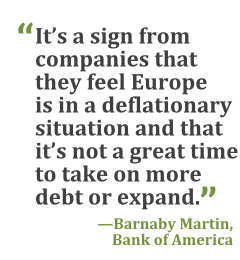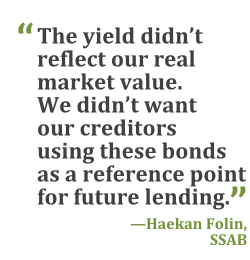For companies with enough cash on their books, there's a silverlining to the stormy credit markets: They can buy back their bondson the cheap.
|European companies including Anglo American Plc, Deutsche BankAG, and Banco Comercial Portugues SA have agreed to buy back bondsat below their face value in recent weeks, generating instantprofit and often reducing their indebtedness in the bargain. Thetransactions can be a way to show strength, an important statementto make in a market where investors are increasingly skepticalabout the credit quality of many borrowers.
| Sofar this year, European companies bought back or announced tendersfor 57 billion euros (US$62 billion), according to DavidLeeming, head of liability management for Royal Bank ofScotland Group Plc in London. That's more than five times theamount for the same period last year, said Leeming, who monitorsbuybacks from companies in Western Europe and Nordic nations insterling, euros, and dollars.
Sofar this year, European companies bought back or announced tendersfor 57 billion euros (US$62 billion), according to DavidLeeming, head of liability management for Royal Bank ofScotland Group Plc in London. That's more than five times theamount for the same period last year, said Leeming, who monitorsbuybacks from companies in Western Europe and Nordic nations insterling, euros, and dollars.
More of these transactions are poised to happen in the comingmonths and years, a development that underscores the fragile stateof European economies. Many companies in the region are awash incash, and don't have enough confidence in their growth prospects tospend it on acquisitions, said Barnaby Martin, a European creditstrategist at Bank of America Corp. Buying back debt is a way toinstead reduce risk, a step that often makes sense when the profitoutlook is less rosy.
|“It's a sign from companies that they feel Europe is in adeflationary situation and that it's not a great time to take onmore debt or expand,” Martin said.
|There may be good reason for companies to have that fear.Consumer prices in the euro area fell 0.2 percent in February fromthe same month last year, according to a report on Monday. Forthree years inflation has fallen short of the European CentralBank's goal of nearly 2 percent. Economic growth in the area wasjust 1.5 percent in the fourth quarter compared with the sameperiod a year earlier.
Buybacks Intended to Soothe Investors
In the case of Deutsche Bank, buybacks were partly meant tosoothe investors concerned about its capital position. On February12, the bank offered to buy back about $5.4 billion of bonds indollars and euros in a series of transactions, after the company'sshares and debt had plunged. On Monday, the bank said that in arecent round of buybacks, investors sought to sell only $740million of dollar bonds to the bank, of the up to $2 billion it waswilling to buy.
|The lender said the low participation rate showed “improvedmarket sentiment and an investor preference to retain exposure.”Deutsche Bank expects to book a 55 million-euro profit in itsfirst-quarter results because of the buybacks, it said.
|Debt buybacks typically make the most sense for companies withrelatively high cash levels, and they're even better for borrowerswith bonds that trade below face value. Still, it's not attractivefor some long-term holders to sell their bonds back below wherethey bought them, said Jonathan Pitkanen, London-based head ofinvestment-grade credit research at Columbia ThreadneedleInvestments, which manages about $200 billion in fixed incomeglobally.
||“Smart companies whose bonds are trading down often try to makethe best of those circumstances,” said John Ericson, a NewYork-based partner in the corporate department at Simpson Thacher& Bartlett.
|Companies repurchasing their notes are often junk rated, but mayalso be investment grade, as Deutsche Bank is. The transactionshave tended to be more common in Europe, while in the UnitedStates, many companies with extra liquidity prefer to buy backshares or acquire competitors, Bank of America's Martin said.
| Lastyear, many liability buybacks were essentially refinancingtransactions, where the borrower would issue new bonds maturing ina few years to pay off notes maturing in the near term. This year,as corporate bond prices fall, more issuers are buying back debt tobook an accounting gain and reduce borrowings, said advisers atbanks that help companies do these transactions.
Lastyear, many liability buybacks were essentially refinancingtransactions, where the borrower would issue new bonds maturing ina few years to pay off notes maturing in the near term. This year,as corporate bond prices fall, more issuers are buying back debt tobook an accounting gain and reduce borrowings, said advisers atbanks that help companies do these transactions.
“When the market is softer, it creates a lot of inquiry fromcompanies about buying back bonds,” said Graham Bahan, theLondon-based head of liability management for Europe, the MiddleEast, and Africa at Citigroup. “We're talking to a lot of companiesabout buybacks. I expect this will be a busy year.”
|“Real Market Value”
These transactions are still relatively rare—the buybackscompleted and announced this year make up less than 1 percent ofthe trillions of dollars of corporate debt in Western European andNordic nations.
|Anglo American said last week that bondholders sought to sellback $1.2 billion of notes denominated in euros and pounds, mostlybelow face value. The company took the measure after being cut tojunk by the three major rating firms, which said that low commodityprices could hinder mine sales and debt reduction.
|Swedish steelmaker SSAB AB chose to buy back bonds afterStandard & Poor's downgraded the company deeper into junkterritory last month. The yield on SSAB's euro-denominated bondsdropped to about 6.6 percent from around 9 percent following theoffer to buy back up to 100 million euros of notes at a minimum of94 cents on the euro.
|“The yield didn't reflect our real market value,” Haekan Folin,chief financial officer at Stockholm-based SSAB, said. “We wantedto show we have the financial strength to do this. We didn't wantour creditors using these bonds as a reference point for futurelending.”
|Companies outside of Europe are doing buybacks, too. FortescueMetals Group Ltd, a Perth, Australia-based iron ore producer, saidbond repurchases have helped it to slash interest costs and offsetsome of the pain created by the commodity price slump.
|The average price on investment-grade corporate bonds worldwidefell to 103 percent of face value last month, while junk bondsdropped to 86 percent, both the lowest since September 2009, Bankof America Merrill Lynch index data show. Those kinds of pricedrops give more companies an incentive to buy back debt.
|“These companies are trying to signal the strength of theirliquidity position,” said Zoso Davies, a credit strategist atBarclays Plc in London. “They're putting their money where theirmouth is.”
|Copyright 2018 Bloomberg. All rightsreserved. This material may not be published, broadcast, rewritten,or redistributed.
Complete your profile to continue reading and get FREE access to Treasury & Risk, part of your ALM digital membership.
Your access to unlimited Treasury & Risk content isn’t changing.
Once you are an ALM digital member, you’ll receive:
- Critical Treasury & Risk information including in-depth analysis of treasury and finance best practices, case studies with corporate innovators, informative newsletters, educational webcasts and videos, and resources from industry leaders.
- Exclusive discounts on ALM and Treasury & Risk events.
- Access to other award-winning ALM websites including PropertyCasualty360.com and Law.com.
*May exclude premium content
Already have an account? Sign In
© 2024 ALM Global, LLC, All Rights Reserved. Request academic re-use from www.copyright.com. All other uses, submit a request to [email protected]. For more information visit Asset & Logo Licensing.







